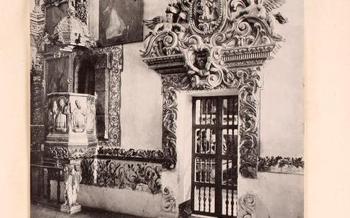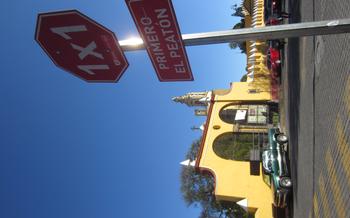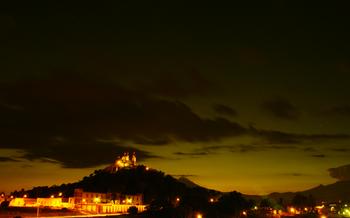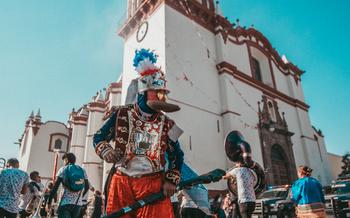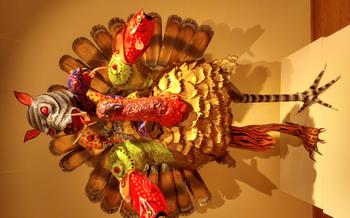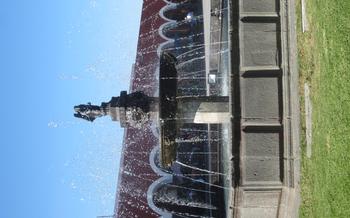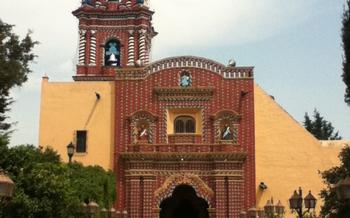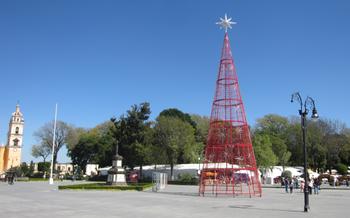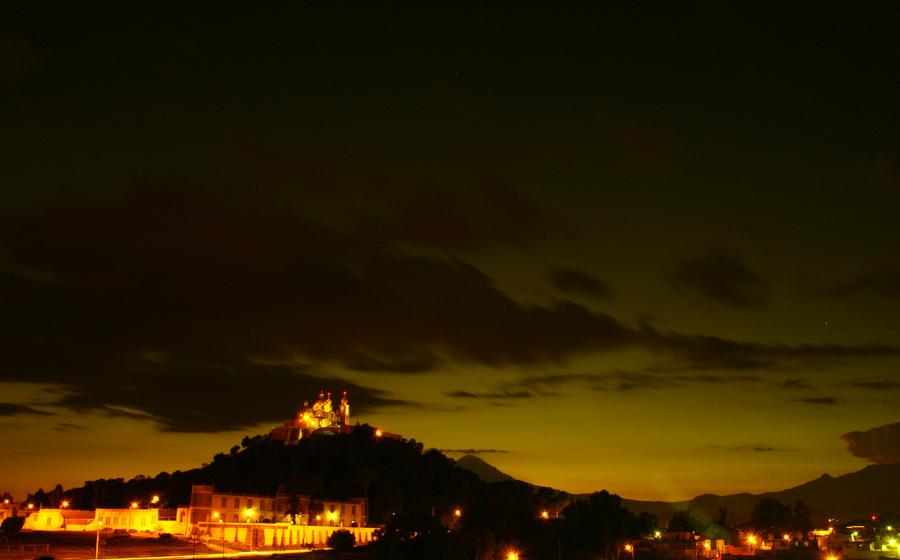
Templo de San Juan Texpolco
- The Majestic Temple of San Juan Texpolco
- Unveiling the Architectural Grandeur
- Unveiling the Symbolism and Iconography
- A Glimpse into the Past: The Templo Museum
- A Place for Reflection and Spirituality
- Discover the Enchanting City of Cholula
- Recommended Tours and Itineraries
- Dress Code and Etiquette
- Photography and Videography Guidelines
- Insider Tip: Unforgettable Views
The Majestic Temple of San Juan Texpolco
In the heart of Cholula, Mexico, stands a testament to faith and architectural prowess – the Templo de San Juan Texpolco. This 16th-century masterpiece is a fusion of indigenous and colonial influences, a symbol of the city's rich heritage. Its historical significance is intertwined with the evangelization of Cholula, as it was one of the first churches built by the Spanish to convert the native population to Christianity.
Beyond its religious importance, the temple is an architectural marvel, showcasing a harmonious blend of Baroque and indigenous styles. Its intricate facade, adorned with carvings and reliefs, narrates biblical stories and depicts saints and angels. The majestic bell tower, a symbol of the church's power and presence, rises above the city, beckoning pilgrims and visitors alike.
Inside, the temple's grandeur continues with stunning murals, artwork, and religious iconography. The sacred space exudes a sense of awe and reverence, inviting worshippers to connect with the divine. The Templo de San Juan Texpolco stands as a testament to the enduring legacy of faith, culture, and artistry that permeates the city of Cholula.
Unveiling the Architectural Grandeur
The Templo de San Juan Texpolco stands as a testament to the Baroque architectural style, showcasing intricate details and ornate embellishments that captivate the eye. Its facade, a masterpiece of Baroque artistry, features a profusion of sculptures, carvings, and reliefs that narrate biblical stories and depict saints and angels. The main entrance, framed by a majestic arch, invites visitors into a world of grandeur and devotion.
Rising above the temple's facade is the majestic bell tower, a symbol of strength and spirituality. Its intricate design, adorned with cherubs and decorative elements, adds a touch of elegance to the temple's silhouette. The tower's bells, with their melodious chimes, echo through the cobblestone streets of Cholula, calling the faithful to prayer and marking the passage of time.
Stepping inside the temple, visitors are greeted by a breathtaking interior that seamlessly blends architectural beauty with religious significance. The walls are adorned with vibrant murals and frescoes, depicting scenes from the Bible and the lives of saints. The intricate artwork, created by talented local artisans, adds a touch of color and spirituality to the sacred space.
Among the most captivating features of the interior are the intricately carved wooden altars, each dedicated to a different saint or religious figure. The main altar, dedicated to San Juan Bautista, is a masterpiece of Baroque craftsmanship, showcasing a profusion of carvings, sculptures, and gold leaf that shimmer in the candlelight.
The Templo de San Juan Texpolco is not just a place of worship but also a treasure trove of architectural and artistic wonders. Its Baroque facade, majestic bell tower, and stunning interior make it a must-visit destination for anyone interested in Mexican history, culture, and architecture.
Unveiling the Symbolism and Iconography
The Templo de San Juan Texpolco is adorned with profound symbolism and iconography that reflects its religious significance and indigenous roots. Its orientation towards the east symbolizes the rising sun, representing the birth of Jesus Christ and the renewal of life. The facade features intricate carvings and sculptures depicting biblical scenes, allegorical figures, and representations of saints and angels. These intricate details narrate stories from the Bible, conveying moral lessons and inspiring devotion among the faithful.
Indigenous influences are evident in the incorporation of local symbols and motifs into the temple's design. The use of traditional colors, patterns, and iconography reflects the rich cultural heritage of the region. These elements blend seamlessly with Catholic symbolism, creating a unique fusion of indigenous and Christian beliefs.
The placement of the temple on a hilltop further enhances its symbolic significance. It stands as a beacon of faith, visible from afar and inviting pilgrims and visitors to seek spiritual enlightenment. The towering bell tower, adorned with intricate carvings and colorful tiles, symbolizes the call to prayer and the connection between heaven and earth.
The interior of the temple is equally captivating, with stunning murals and artwork depicting biblical scenes and the life of San Juan Bautista. These vibrant and expressive paintings serve as powerful visual aids, educating and inspiring the faithful. The intricate details and symbolism in the artwork invite visitors to contemplate the deeper meanings and messages conveyed within the temple walls.
A Glimpse into the Past: The Templo Museum
The Templo de San Juan Texpolco is not merely a magnificent architectural marvel but also home to a fascinating museum that offers a glimpse into the temple's rich history and cultural significance. Step inside, and you'll be transported back in time as you explore exhibits showcasing the temple's evolution from its pre-Columbian origins to its present-day splendor.
Discover artifacts unearthed during archaeological excavations that shed light on the temple's ancient foundations. Marvel at religious objects and liturgical items that have been meticulously preserved, offering insights into the spiritual practices of the past. Learn about the daily life of the community through captivating displays that showcase traditional clothing, tools, and domestic items.
The Templo Museum is a treasure trove of knowledge and history, providing visitors with a deeper understanding of the temple's role in the cultural and religious fabric of Cholula. Immerse yourself in the stories and artifacts that bring the temple's past to life, making your visit an unforgettable and enriching experience.
A Place for Reflection and Spirituality
Amidst the vibrant energy of Cholula, the Templo de San Juan Texpolco offers a sanctuary of peace and tranquility. Its serene surroundings and tranquil atmosphere invite visitors to slow down, reflect, and connect with their spiritual side. The temple's sacred space fosters a sense of contemplation and introspection, making it an ideal destination for those seeking a deeper connection with themselves and their beliefs. Whether you're a religious pilgrim or simply seeking a moment of peace, the Templo de San Juan Texpolco provides a sanctuary for spiritual exploration and rejuvenation.
Discover the Enchanting City of Cholula
Beyond the Templo de San Juan Texpolco, Cholula itself is a treasure trove of history, culture, and natural beauty. Known as the "City of Churches," it boasts over 30 churches and convents, each with its own unique architectural style and historical significance. Among them, the majestic Catedral de Cholula is a must-see, with its impressive facade and intricate interior.
Cholula's most iconic landmark is the Great Pyramid, the largest pyramid in the world by volume. While not as tall as the pyramids of Giza, the Great Pyramid of Cholula is still an impressive sight, with its massive base and several layers of construction. Visitors can climb to the top for panoramic views of the city and the surrounding countryside.
In addition to its historical and cultural attractions, Cholula is also known for its vibrant art scene. The city is home to numerous galleries and studios, showcasing the works of local and international artists. Visitors can also enjoy traditional Mexican cuisine in one of the many restaurants and cafes, or browse the local markets for unique souvenirs and handicrafts.
With its rich history, stunning architecture, and vibrant cultural scene, Cholula is a city that should not be missed. Whether you're interested in history, culture, art, or simply soaking up the local atmosphere, Cholula has something to offer every traveler.
Recommended Tours and Itineraries
Half-Day Itinerary:
-
Start your day with an early morning visit to the Templo de San Juan Texpolco to avoid crowds and capture the tranquility of the site.
-
Take your time to explore the temple's exterior, admire its architectural details, and immerse yourself in its rich history and symbolism.
-
Step inside to marvel at the intricate murals, artwork, and religious artifacts that adorn the interior.
-
Conclude your visit with a stroll through the charming streets of Cholula, soaking in the colonial atmosphere and visiting other nearby attractions.
Full-Day Itinerary:
-
Begin your day with a guided tour of the Templo de San Juan Texpolco, gaining insights into its history, significance, and unique features.
-
Dedicate the afternoon to exploring the Great Pyramid of Cholula, climbing to the top for panoramic views of the city and the surrounding countryside.
-
Discover the fascinating history of Cholula at the Museo de la Ciudad de Cholula, showcasing artifacts from the city's pre-Columbian and colonial past.
-
Indulge in a traditional Mexican lunch at one of the local restaurants, savoring the flavors and aromas of the region's cuisine.
Incorporating the Temple Visit into a Broader Itinerary:
-
Combine your visit to the Templo de San Juan Texpolco with a day trip to the nearby city of Puebla, renowned for its colonial architecture, vibrant markets, and delicious cuisine.
-
Explore the archaeological sites of Cacaxtla and Xochicalco, located within easy reach of Cholula, to delve deeper into the region's rich pre-Columbian heritage.
-
Embark on a multi-day adventure, using Cholula as your base to explore the diverse attractions of the surrounding region, including ancient ruins, natural wonders, and charming colonial towns.
Dress Code and Etiquette
When visiting the Templo de San Juan Texpolco, it is essential to dress respectfully, considering the religious significance of the site. Opt for modest attire that covers your shoulders and knees. Avoid wearing shorts, tank tops, or revealing clothing. As a guest in the local community, it is important to show respect for their customs and traditions. Be mindful of your behavior and maintain a quiet and reverent demeanor within the temple. Refrain from talking loudly or engaging in disruptive activities. If you have any questions or concerns, do not hesitate to ask a local guide or staff member for guidance. By adhering to these simple guidelines, you can contribute to preserving the sacred atmosphere of the temple while also showing respect for the local culture.
Photography and Videography Guidelines
When it comes to capturing the beauty of the Templo de San Juan Texpolco through photography or videography, it is essential to be mindful of the temple's sacred nature and adhere to the established guidelines. While photography and videography are generally permitted within the temple grounds, there are certain areas where these activities may be restricted. For instance, taking photos or videos inside the sanctuary or during religious ceremonies is strictly prohibited.
It is important to be respectful of the privacy of other visitors and avoid using flash photography or tripods that may obstruct or disturb their experience. When capturing images of people, it is courteous to ask for their permission beforehand.
To ensure the preservation of the temple's artistic and historical integrity, the use of drones or any other aerial photography equipment is prohibited. It is also essential to refrain from touching or leaning against the temple's walls or artwork to prevent any damage.
By following these guidelines, visitors can contribute to the preservation of this sacred site while capturing beautiful and respectful images of the Templo de San Juan Texpolco.
Insider Tip: Unforgettable Views
While exploring the Templo de San Juan Texpolco, don't miss the chance to capture unforgettable views of the temple and its surroundings. For a breathtaking panorama, head to the nearby hilltop, where you'll be rewarded with sweeping vistas of the temple, the city of Cholula, and the majestic Popocatépetl volcano in the distance. This spot offers the perfect vantage point to capture the grandeur of the temple against the backdrop of the picturesque Mexican landscape.
For an even more magical experience, plan your visit during sunrise or sunset. As the golden hues of the sky bathe the temple in a warm glow, you'll witness a spectacle that will leave you in awe. The play of light and shadow on the intricate facade creates a captivating sight that's sure to produce stunning photographs. Embrace the opportunity to capture the essence of this sacred space in all its glory, and take home memories that will last a lifetime.
